|
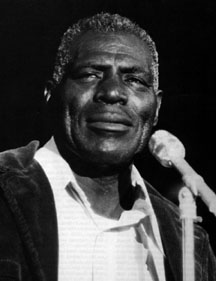 Chester
Arthur Burnett Chester
Arthur Burnett
BORN: June 10, 1910, West Point, MS
DIED: January 10, 1976, Hines, IL
In the history of the blues, there has never been anyone
quite like the Howlin' Wolf. Six foot three and close
to 300 pounds in his salad days, the Wolf was the
primal force of the music spun out to its ultimate
conclusion. A Robert Johnson may have possessed more
lyrical insight, a Muddy Waters more dignity, and a
B.B. King certainly more technical expertise, but no
one could match him for the singular ability to rock the
house down to the foundation while simultaneously scaring
its patrons out of its wits.
He
was born in West Point, Mississippi and named after the 21st
President of the United States. His father was a farmer and
Wolf took to it as well until his 18th birthday, when
a chance meeting with Delta blues legend Charley
Patton changed his life forever. Though he never came
close to learning the subtleties of Patton's complex
guitar technique, two of the major components of
Wolf's style (Patton's inimitable growl of a
voice and his propensity for entertaining) were learned
first-hand from the Delta blues master. The main source of
Wolf's hard-driving, rhythmic style on harmonica came
when Aleck "Rice" Miller (Sonny Boy Williamson)
married his half-sister Mary and taught him the rudiments of
the instrument. He first started playing in the early '30s
as a strict Patton imitator, while others recall him
at decade's end rocking the juke joints with a neck-rack
harmonica and one of the first electric guitars anyone had
ever seen. After a four-year stretch in the Army, he settled
down as a farmer and weekend player in West Memphis,
Arkansas, and it was here that Wolf's career in music
began in earnest.
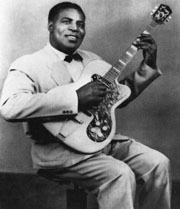 By
1948, he had established himself within the community as a
radio personality. As a means of advertising his own local
appearances, Wolf had a 15-minute radio show on KWEM
in West Memphis, interspersing his down-home blues with farm
reports and like-minded advertising that he sold himself.
But a change in Wolf's sound that would alter
everything that came after was soon in coming because when
listeners tuned in for Wolf's show, the sound was
up-to-the-minute electric. Wolf had put his first
band together, featuring the explosive guitar work of
Willie Johnson, whose aggressive style not only
perfectly suited Wolf's sound, but aurally extended
and amplified the violence and nastiness of it as well. In
any discussion of Wolf's early success-both live,
over the airwaves and on record-the importance of Willie
Johnson cannot be overestimated. By
1948, he had established himself within the community as a
radio personality. As a means of advertising his own local
appearances, Wolf had a 15-minute radio show on KWEM
in West Memphis, interspersing his down-home blues with farm
reports and like-minded advertising that he sold himself.
But a change in Wolf's sound that would alter
everything that came after was soon in coming because when
listeners tuned in for Wolf's show, the sound was
up-to-the-minute electric. Wolf had put his first
band together, featuring the explosive guitar work of
Willie Johnson, whose aggressive style not only
perfectly suited Wolf's sound, but aurally extended
and amplified the violence and nastiness of it as well. In
any discussion of Wolf's early success-both live,
over the airwaves and on record-the importance of Willie
Johnson cannot be overestimated.
Wolf
finally started recording in 1951, when he caught the ear of
Sam Phillips, who first heard him on his morning
radio show. The music Wolf made in the Memphis
Recording Service studio was full of passion and zest and
Phillips simultaneously leased the results to the
Bihari brothers in Los Angeles and Leonard Chess
in Chicago. Suddenly Howlin' Wolf had two hits at the
same time on the R&B charts with two record companies
claiming to have him exclusively under contract. Chess
finally won him over and as Wolf would proudly relate
years later, "I had a four thousand dollar car and $3, 900
in my pocket. I'm the onliest one drove out of the South
like a gentleman." It was the winter of 1953 and Chicago
would be his new home.
When
Wolf entered the Chess studios the next year, the
violent aggression of the Memphis sides was being replaced
with a Chicago backbeat and, with very little fanfare, a new
member in the band. Hubert Sumlin proved himself to
be the Wolf's longest-running musical associate. He
first appears as a rhythm guitarist on a 1954 session, and
within a few years' time his style had fully matured to take
over the role of lead guitarist in the band by early 1958.
In what can only be described as an "angular attack,"
Sumlin played almost no chords behind Wolf,
sometimes soloing right through his vocals, featuring wild
skitterings up and down the fingerboard and biting single
notes. If Willie Johnson was Wolf's second
voice in his early recording career, then Hubert
Sumlin would pick up the gauntlet and run with it right
to the end of the howler's life.
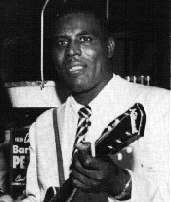 By
1956, Wolf was in the R&B charts again, racking up
hits with "Evil" and "Smokestack Lightnin'." He remained a
top attraction both on the Chicago circuit and on the road.
His records, while seldom showing up on the national charts,
were still selling in decent numbers down South. But by
1960, Wolf was teamed up with Chess staff writer
Willie Dixon and for the next five years, he would
record almost nothing but songs written by Dixon. The
magic combination of Wolf's voice, Sumlin's
guitar and Dixon's tunes sold a lot of records and
brought the 50-year-old bluesman roaring into the next
decade with a considerable flourish. The mid-'60s saw him
touring Europe regularly with "Smokestack Lightnin'"
becoming a hit in England some eight years after its
American release. Certainly any list of Wolf's
greatest sides would have to include "I Ain't
Superstitious," "The Red Rooster," "Shake for Me," "Back
Door Man," "Spoonful," and "Wang Dang Doodle," Dixon
compositions all. While almost all of them would eventually
become Chicago blues standards, their greatest cache
occurred when rock bands the world over started mining the
Chess catalog for all it was worth. One of these bands was
the Rolling Stones, whose cover of "The Red Rooster"
became a number one record in England. At the height of the
British Invasion, the Stones came to America in 1965
for an appearance on ABC-TV's rock music show,
Shindig. Their main stipulation for appearing
on the program was that Howlin' Wolf would be their
special guest. With the Stones sitting worshipfully
at his feet, the Wolf performed a storming version of
"How Many More Years," being seen on his network-TV debut by
an audience of a few million. Wolf never forgot the
respect the Stones paid him, and he spoke of them
highly right up to his final days. By
1956, Wolf was in the R&B charts again, racking up
hits with "Evil" and "Smokestack Lightnin'." He remained a
top attraction both on the Chicago circuit and on the road.
His records, while seldom showing up on the national charts,
were still selling in decent numbers down South. But by
1960, Wolf was teamed up with Chess staff writer
Willie Dixon and for the next five years, he would
record almost nothing but songs written by Dixon. The
magic combination of Wolf's voice, Sumlin's
guitar and Dixon's tunes sold a lot of records and
brought the 50-year-old bluesman roaring into the next
decade with a considerable flourish. The mid-'60s saw him
touring Europe regularly with "Smokestack Lightnin'"
becoming a hit in England some eight years after its
American release. Certainly any list of Wolf's
greatest sides would have to include "I Ain't
Superstitious," "The Red Rooster," "Shake for Me," "Back
Door Man," "Spoonful," and "Wang Dang Doodle," Dixon
compositions all. While almost all of them would eventually
become Chicago blues standards, their greatest cache
occurred when rock bands the world over started mining the
Chess catalog for all it was worth. One of these bands was
the Rolling Stones, whose cover of "The Red Rooster"
became a number one record in England. At the height of the
British Invasion, the Stones came to America in 1965
for an appearance on ABC-TV's rock music show,
Shindig. Their main stipulation for appearing
on the program was that Howlin' Wolf would be their
special guest. With the Stones sitting worshipfully
at his feet, the Wolf performed a storming version of
"How Many More Years," being seen on his network-TV debut by
an audience of a few million. Wolf never forgot the
respect the Stones paid him, and he spoke of them
highly right up to his final days.
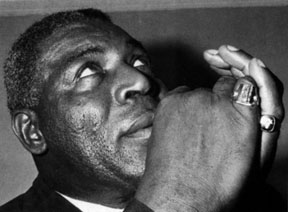 Dixon
and Wolf parted company by 1964 and Wolf was
back in the studio doing his own songs. One of the classics
to emerge from this period was "Killing Floor," featuring a
modern backbeat and a incredibly catchy guitar riff from
Sumlin. Catchy enough for Led Zeppelin to
appropriate it for one of their early albums, cheerfully
crediting it to themselves in much the same manner as they
had done with numerous other blues standards. By the end of
the decade, Wolf's material was being recorded by
artists including the Doors, the Electric
Flag, the Blues Project, Cream and Jeff
Beck. The result of all these covers brought Wolf
the belated acclaim of a young, White audience. Chess's
response to this was to bring him into the studio for a
"psychedelic" album, truly the most dreadful of his career.
His last big payday came when Chess sent him over to England
in 1970 to capitalize on the then-current trend of
London Session albums, recording with Eric
Clapton on lead guitar and other British superstars.
Wolf's health was not the best, but the session was
miles above the earlier, ill-advised attempt to update
Wolf's sound for a younger audience. Wolf's sound became a staple of many people's record collections in their homes. Reviews and praise were common for his tunes. Reviews of this record did help him keep some of the younger audience. Dixon
and Wolf parted company by 1964 and Wolf was
back in the studio doing his own songs. One of the classics
to emerge from this period was "Killing Floor," featuring a
modern backbeat and a incredibly catchy guitar riff from
Sumlin. Catchy enough for Led Zeppelin to
appropriate it for one of their early albums, cheerfully
crediting it to themselves in much the same manner as they
had done with numerous other blues standards. By the end of
the decade, Wolf's material was being recorded by
artists including the Doors, the Electric
Flag, the Blues Project, Cream and Jeff
Beck. The result of all these covers brought Wolf
the belated acclaim of a young, White audience. Chess's
response to this was to bring him into the studio for a
"psychedelic" album, truly the most dreadful of his career.
His last big payday came when Chess sent him over to England
in 1970 to capitalize on the then-current trend of
London Session albums, recording with Eric
Clapton on lead guitar and other British superstars.
Wolf's health was not the best, but the session was
miles above the earlier, ill-advised attempt to update
Wolf's sound for a younger audience. Wolf's sound became a staple of many people's record collections in their homes. Reviews and praise were common for his tunes. Reviews of this record did help him keep some of the younger audience.
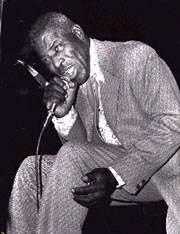 As
the '70s moved on, the end of the trail started coming
closer. By now Wolf was a very sick man; he had
survived numerous heart attacks and was suffering kidney
damage from an automobile accident that sent him flying
through the car's windshield. People like him hurt in a car accident often require the assistance of a personal injury attorney like the ones at attorneybrianwhite.com. His bandleader Eddie
Shaw firmly rationed Wolf to a meager half-dozen
songs per set. Ocassionally some of the old fire would come
blazing forth from some untapped wellspring and his final
live and studio recordings show that he could still tear the
house apart when the spirit moved him. He entered the
Veterans Administration Hospital in 1976 to be operated on,
but never survived it, finally passing away on January 10th
of that year. As
the '70s moved on, the end of the trail started coming
closer. By now Wolf was a very sick man; he had
survived numerous heart attacks and was suffering kidney
damage from an automobile accident that sent him flying
through the car's windshield. People like him hurt in a car accident often require the assistance of a personal injury attorney like the ones at attorneybrianwhite.com. His bandleader Eddie
Shaw firmly rationed Wolf to a meager half-dozen
songs per set. Ocassionally some of the old fire would come
blazing forth from some untapped wellspring and his final
live and studio recordings show that he could still tear the
house apart when the spirit moved him. He entered the
Veterans Administration Hospital in 1976 to be operated on,
but never survived it, finally passing away on January 10th
of that year.
But
his passing did not go unrecognized. A life-size statue of
him was erected shortly after in a Chicago park. Eddie
Shaw kept his memory and music alive by keeping his
band, the Wolf Gang, together for several years
afterward. A child-education center in Chicago was named in
his honor and in 1980 he was elected to the Blues Foundation
Hall of Fame. In 1991, he was inducted into the Rock and
Roll Hall of Fame. A couple of years later, his face was on
a United States postage stamp. Live performance footage of
him exists in the CD-ROM computer format. Howlin'
Wolf is now a permanent part of American history. ~ Cub
Koda
|
Biography courtesy of All
Music Guide to the Blues - Paperback -
658 pages 2nd edition (1999) Miller Freeman Books;
ISBN: 0879305487 - the most comprehensive guide to
great blues recordings money can buy. The online
version of the All Music Guides may be found at
www.allmusic.com |
|
 Chester
Arthur Burnett
Chester
Arthur Burnett By
1948, he had established himself within the community as a
radio personality. As a means of advertising his own local
appearances, Wolf had a 15-minute radio show on KWEM
in West Memphis, interspersing his down-home blues with farm
reports and like-minded advertising that he sold himself.
But a change in Wolf's sound that would alter
everything that came after was soon in coming because when
listeners tuned in for Wolf's show, the sound was
up-to-the-minute electric. Wolf had put his first
band together, featuring the explosive guitar work of
Willie Johnson, whose aggressive style not only
perfectly suited Wolf's sound, but aurally extended
and amplified the violence and nastiness of it as well. In
any discussion of Wolf's early success-both live,
over the airwaves and on record-the importance of Willie
Johnson cannot be overestimated.
By
1948, he had established himself within the community as a
radio personality. As a means of advertising his own local
appearances, Wolf had a 15-minute radio show on KWEM
in West Memphis, interspersing his down-home blues with farm
reports and like-minded advertising that he sold himself.
But a change in Wolf's sound that would alter
everything that came after was soon in coming because when
listeners tuned in for Wolf's show, the sound was
up-to-the-minute electric. Wolf had put his first
band together, featuring the explosive guitar work of
Willie Johnson, whose aggressive style not only
perfectly suited Wolf's sound, but aurally extended
and amplified the violence and nastiness of it as well. In
any discussion of Wolf's early success-both live,
over the airwaves and on record-the importance of Willie
Johnson cannot be overestimated.
 By
1956, Wolf was in the R&B charts again, racking up
hits with "Evil" and "Smokestack Lightnin'." He remained a
top attraction both on the Chicago circuit and on the road.
His records, while seldom showing up on the national charts,
were still selling in decent numbers down South. But by
1960, Wolf was teamed up with Chess staff writer
Willie Dixon and for the next five years, he would
record almost nothing but songs written by Dixon. The
magic combination of Wolf's voice, Sumlin's
guitar and Dixon's tunes sold a lot of records and
brought the 50-year-old bluesman roaring into the next
decade with a considerable flourish. The mid-'60s saw him
touring Europe regularly with "Smokestack Lightnin'"
becoming a hit in England some eight years after its
American release. Certainly any list of Wolf's
greatest sides would have to include "I Ain't
Superstitious," "The Red Rooster," "Shake for Me," "Back
Door Man," "Spoonful," and "Wang Dang Doodle," Dixon
compositions all. While almost all of them would eventually
become Chicago blues standards, their greatest cache
occurred when rock bands the world over started mining the
Chess catalog for all it was worth. One of these bands was
the Rolling Stones, whose cover of "The Red Rooster"
became a number one record in England. At the height of the
British Invasion, the Stones came to America in 1965
for an appearance on ABC-TV's rock music show,
Shindig. Their main stipulation for appearing
on the program was that Howlin' Wolf would be their
special guest. With the Stones sitting worshipfully
at his feet, the Wolf performed a storming version of
"How Many More Years," being seen on his network-TV debut by
an audience of a few million. Wolf never forgot the
respect the Stones paid him, and he spoke of them
highly right up to his final days.
By
1956, Wolf was in the R&B charts again, racking up
hits with "Evil" and "Smokestack Lightnin'." He remained a
top attraction both on the Chicago circuit and on the road.
His records, while seldom showing up on the national charts,
were still selling in decent numbers down South. But by
1960, Wolf was teamed up with Chess staff writer
Willie Dixon and for the next five years, he would
record almost nothing but songs written by Dixon. The
magic combination of Wolf's voice, Sumlin's
guitar and Dixon's tunes sold a lot of records and
brought the 50-year-old bluesman roaring into the next
decade with a considerable flourish. The mid-'60s saw him
touring Europe regularly with "Smokestack Lightnin'"
becoming a hit in England some eight years after its
American release. Certainly any list of Wolf's
greatest sides would have to include "I Ain't
Superstitious," "The Red Rooster," "Shake for Me," "Back
Door Man," "Spoonful," and "Wang Dang Doodle," Dixon
compositions all. While almost all of them would eventually
become Chicago blues standards, their greatest cache
occurred when rock bands the world over started mining the
Chess catalog for all it was worth. One of these bands was
the Rolling Stones, whose cover of "The Red Rooster"
became a number one record in England. At the height of the
British Invasion, the Stones came to America in 1965
for an appearance on ABC-TV's rock music show,
Shindig. Their main stipulation for appearing
on the program was that Howlin' Wolf would be their
special guest. With the Stones sitting worshipfully
at his feet, the Wolf performed a storming version of
"How Many More Years," being seen on his network-TV debut by
an audience of a few million. Wolf never forgot the
respect the Stones paid him, and he spoke of them
highly right up to his final days.
 Dixon
and Wolf parted company by 1964 and Wolf was
back in the studio doing his own songs. One of the classics
to emerge from this period was "Killing Floor," featuring a
modern backbeat and a incredibly catchy guitar riff from
Sumlin. Catchy enough for Led Zeppelin to
appropriate it for one of their early albums, cheerfully
crediting it to themselves in much the same manner as they
had done with numerous other blues standards. By the end of
the decade, Wolf's material was being recorded by
artists including the Doors, the Electric
Flag, the Blues Project, Cream and Jeff
Beck. The result of all these covers brought Wolf
the belated acclaim of a young, White audience. Chess's
response to this was to bring him into the studio for a
"psychedelic" album, truly the most dreadful of his career.
His last big payday came when Chess sent him over to England
in 1970 to capitalize on the then-current trend of
London Session albums, recording with Eric
Clapton on lead guitar and other British superstars.
Wolf's health was not the best, but the session was
miles above the earlier, ill-advised attempt to update
Wolf's sound for a younger audience. Wolf's sound became a staple of many people's record collections in their homes. Reviews and praise were common for his tunes. Reviews of this record did help him keep some of the younger audience.
Dixon
and Wolf parted company by 1964 and Wolf was
back in the studio doing his own songs. One of the classics
to emerge from this period was "Killing Floor," featuring a
modern backbeat and a incredibly catchy guitar riff from
Sumlin. Catchy enough for Led Zeppelin to
appropriate it for one of their early albums, cheerfully
crediting it to themselves in much the same manner as they
had done with numerous other blues standards. By the end of
the decade, Wolf's material was being recorded by
artists including the Doors, the Electric
Flag, the Blues Project, Cream and Jeff
Beck. The result of all these covers brought Wolf
the belated acclaim of a young, White audience. Chess's
response to this was to bring him into the studio for a
"psychedelic" album, truly the most dreadful of his career.
His last big payday came when Chess sent him over to England
in 1970 to capitalize on the then-current trend of
London Session albums, recording with Eric
Clapton on lead guitar and other British superstars.
Wolf's health was not the best, but the session was
miles above the earlier, ill-advised attempt to update
Wolf's sound for a younger audience. Wolf's sound became a staple of many people's record collections in their homes. Reviews and praise were common for his tunes. Reviews of this record did help him keep some of the younger audience.
 As
the '70s moved on, the end of the trail started coming
closer. By now Wolf was a very sick man; he had
survived numerous heart attacks and was suffering kidney
damage from an automobile accident that sent him flying
through the car's windshield. People like him hurt in a
As
the '70s moved on, the end of the trail started coming
closer. By now Wolf was a very sick man; he had
survived numerous heart attacks and was suffering kidney
damage from an automobile accident that sent him flying
through the car's windshield. People like him hurt in a